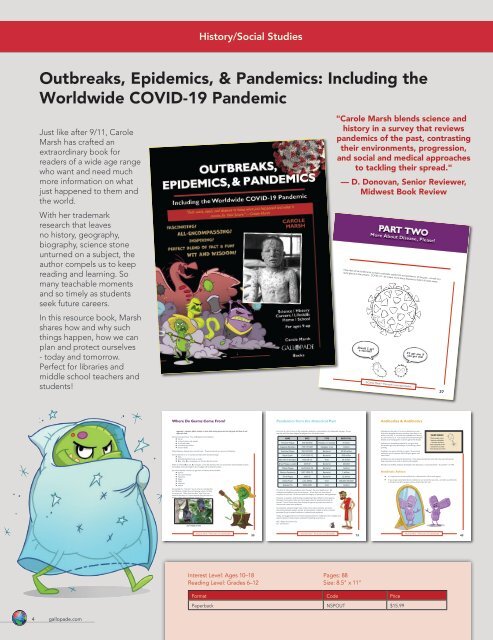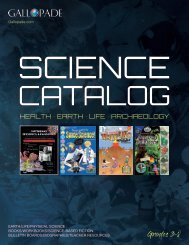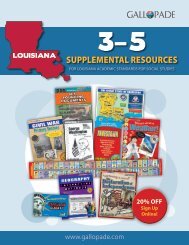Create successful ePaper yourself
Turn your PDF publications into a flip-book with our unique Google optimized e-Paper software.
History/Social Studies<br />
Outbreaks, Epidemics, & Pandemics: Including the<br />
Worldwide COVID-19 Pandemic<br />
Just like after 9/11, Carole<br />
Marsh has crafted an<br />
extraordinary book for<br />
readers of a wide age range<br />
who want and need much<br />
more information on what<br />
just happened to them and<br />
the world.<br />
With her trademark<br />
research that leaves<br />
no history, geography,<br />
biography, science stone<br />
unturned on a subject, the<br />
author compels us to keep<br />
reading and learning. So<br />
many teachable moments<br />
and so timely as students<br />
seek future careers.<br />
In this resource book, Marsh<br />
shares how and why such<br />
things happen, how we can<br />
plan and protect ourselves<br />
- today and tomorrow.<br />
Perfect for libraries and<br />
middle school teachers and<br />
students!<br />
"Carole Marsh blends science and<br />
history in a survey that reviews<br />
pandemics of the past, contrasting<br />
their environments, progression,<br />
and social and medical approaches<br />
to tackling their spread."<br />
— D. Donovan, Senior Reviewer,<br />
Midwest Book Review<br />
PART TWO<br />
More About Disease, Please!<br />
Now that we’ve looked a bit at major outbreaks, epidemics, and pandemics of the past—as well as a<br />
quick glance at the present: COVID-19—let’s learn more about diseases to help it all make sense.<br />
Should I get<br />
a vaccine?<br />
©Carole Marsh • This book is not reproducible<br />
I’ll get one if<br />
you get one!<br />
27<br />
Where Do Germs Come From?<br />
Pandemics from the Historical Past<br />
Antibodies & Antibiotics<br />
reservoir: a person, plant, animal, or other host where germs can live and grow, but they do not<br />
affect the host<br />
Germs live everywhere! You can find germs (microbes) in:<br />
➡ the air<br />
➡ on food, plants, and animals<br />
➡ in soil and water<br />
➡ on almost any surface<br />
➡ on your body<br />
Many infectious diseases live in animal hosts. These animals act as a reservoir of infection.<br />
Germs that live on or in animals can infect other animals through:<br />
➡ bites<br />
➡ contaminated food, soil, or water<br />
➡ fleas, ticks, flies, mosquitoes, or lice that bite the animal<br />
Let’s look at a list of some of the outbreaks, epidemics, and pandemics that happened long ago. As you<br />
see, the world has been plagued by plagues since the earliest times.<br />
NAME DATE TYPE DEATH TOLL<br />
Antonine Plague 165-180 BCE Smallpox or measles 5 million<br />
Japanese Epidemic 735-737 BCE Smallpox virus 1 million<br />
Justinian Plague 541-542 BCE Bacterial 30-50 million<br />
Black Death 1347-1351 CE Bacterial 200 million<br />
New World Smallpox 1520 CE-on Viral 56 million<br />
Antibodies are the parts of a virus or bacterium in your<br />
body that recognize the same microbes when they try to<br />
attack your body. If you have the antibodies of a disease, FACT-ERIA!<br />
you are immune to it. You can get immunity by having the Most people carry<br />
disease or by having gotten a vaccine against the disease.<br />
leprosy antibodies<br />
because we have<br />
Antibiotics are chemicals produced by one germ that<br />
been exposed to the<br />
kills another germ by destroying it or preventing it from<br />
bacterium at some<br />
growing.<br />
time during our lives!<br />
Antibiotics can occur naturally in nature. Some natural<br />
antibiotics can kill a person while killing the germs that<br />
infect them!<br />
Antibiotics are also created in laboratories. Once tested and proven to be safe, they are produced by<br />
drug companies to be sold to doctors and hospitals.<br />
When an infected flea, tick, fly, mosquito, or lice bite humans, they can transmit the animal disease to them.<br />
Fortunately, most animal germs do not adapt well to living in humans.<br />
Just a few diseases a human can get from an infected animal include:<br />
➡ anthrax<br />
➡ cat-scratch disease<br />
➡ hantavirus<br />
➡ plague<br />
➡ rabies<br />
➡ tularemia<br />
➡ malaria<br />
Great Plague, London 1665 CE Bacterial 100,000<br />
Italian Plague 1629-1631 CE Bacterial 1 million<br />
Cholera Pandemics 1817-1923 CE Bacterial 1 million+<br />
Third Plague 1885 CE Bacterial 12 million<br />
Yellow Fever Late 1800s Viral 100,000-150,000<br />
Russian Flu 1889-1890 Viral 1 million<br />
Penicillin was the first antibiotic developed in the laboratory. It was discovered—by accident—in 1940.<br />
Antibiotic Advice:<br />
➡ It is important not to take antibiotics for a disease that it will not work against.<br />
➡ If you do get a prescription for an antibiotic, be sure to take ALL your pills—even after you feel better,<br />
or the germs will flare up again and you will be sicker than ever.<br />
An example of a “reservoir” may be a bat or a monkey that<br />
has infectious microbes living and growing in them, but they<br />
do not get sick. When these microbes “jump” from one<br />
animal to the other, or in some instances, from the host to a<br />
person—that’s when the disease “breaks out.”<br />
This list is of only some pandemics over the years, the more deadly ones. But<br />
outbreaks and epidemics are not uncommon. In fact, they can occur almost<br />
anywhere, at any time. All do not reach the category of pandemic, thank goodness.<br />
However, as people in small hunting and gathering tribes shifted to more agrarian<br />
(farming) communities, there was more opportunity for people and animals to<br />
interact. And so, there were more chances for germs to jump from animals to<br />
humans and create more epidemics.<br />
As civilization advanced, larger cities, trade across nations and seas, and more<br />
interactions between people, animals, and ecosystems created an almost constant<br />
guarantee for germ spread, epidemics, outbreaks, and pandemics.<br />
Today, we struggle with how to learn from past pandemics, implement new strategies, and<br />
respond quickly to help stop an outbreak from getting away from us.<br />
Just hanging around.<br />
BCE: Before the Common Era<br />
CE: Common Era<br />
©Carole Marsh • This book is not reproducible<br />
33<br />
©Carole Marsh • This book is not reproducible<br />
13<br />
©Carole Marsh • This book is not reproducible<br />
43<br />
Interest Level: Ages 10–18<br />
Reading Level: Grades 6–12<br />
Pages: 88<br />
Size: 8.5" x 11"<br />
Format Code Price<br />
Paperback NSPOUT $15.99<br />
4 gallopade.com
















